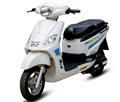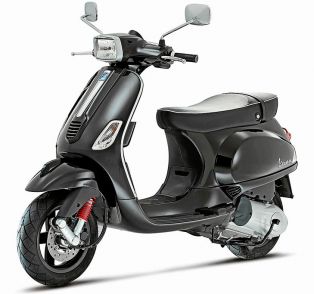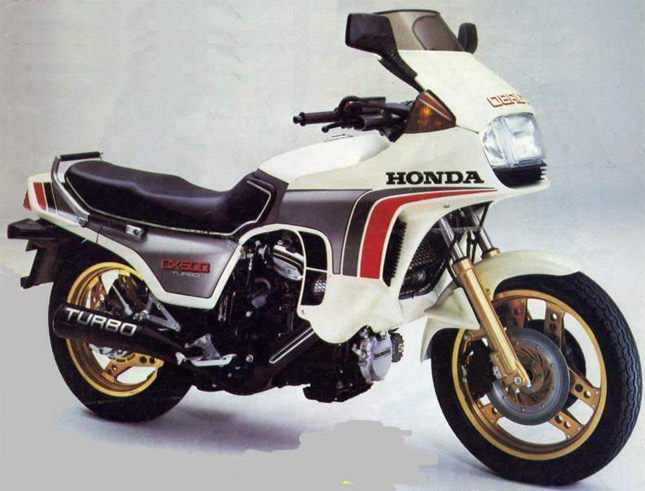 At some point in the late spring, you might begin to notice that the daylight is blurring prior, that the evenings are getting to be cooler. You may consider your mental rundown of things to do while the climate is warm and understand that you didn't do half of them. You may conclude that the time has come to get up to speed.
At some point in the late spring, you might begin to notice that the daylight is blurring prior, that the evenings are getting to be cooler. You may consider your mental rundown of things to do while the climate is warm and understand that you didn't do half of them. You may conclude that the time has come to get up to speed.Huge numbers of the motorcyclists born right after World War II were entering the midyear i.e. SUMMER of their lives in the 1970s, and by the mid Eighties a hefty portion of them were starting to feel a chill noticeable all around. Some chose to enjoy one final hurrah before settling down and raising a crew!! Yes a FAMILY. Some went out and purchased a Honda CX500 Turbo.
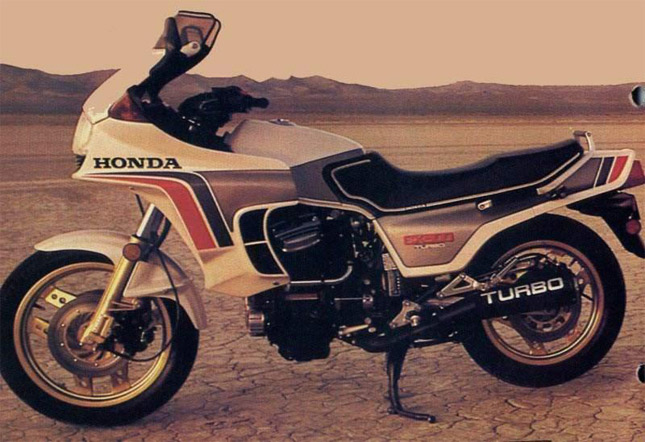
*** Very stance of CX500 and its staggering on road performance is eye-popping
Honda began the brief design for turbo-charging when it introduced the CX500 Turbo in 1981. Taking into account the humble however in technically advanced and adaptable CX500, it bragged a course book brimming with innovative advances. Not slightest among these was Honda's first fuel infusion framework, the PGM F1 infusion framework, which just got to be ordinary on Honda bikes from the late 1990s, is gotten from it, yet there was likewise hostile to dive front forks, a mono-shock rear suspension framework and an extremely efficient and stylish (for the times) touring fairing with novel faired-in indicators.
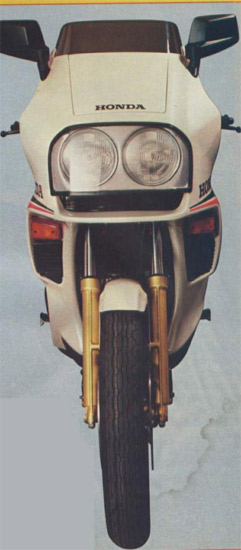 So not only was the CX500 Turbo a massive accomplishment, it had been a huge undertaking by Big H. But the most compelling measure of its success was the simple fact that CX500 Turbo worked well, too. Here as a 497cc machine capable nearly 130mph unheard of in 1981. What's more it was comfortable, sophisticated and even handled reasonably for a 235kg machine.
So not only was the CX500 Turbo a massive accomplishment, it had been a huge undertaking by Big H. But the most compelling measure of its success was the simple fact that CX500 Turbo worked well, too. Here as a 497cc machine capable nearly 130mph unheard of in 1981. What's more it was comfortable, sophisticated and even handled reasonably for a 235kg machine.The CX500 Turbo with which Honda dazed the bike world in 1982 was one of the most improbable bikes ever to be put into production. The turbocharged V-twin was large, overwhelming, mind boggling and expensive. From the minute it was unveiled, numerous onlookers viewed the Turbo as all the more a corporate proclamation than a genuine superbike.
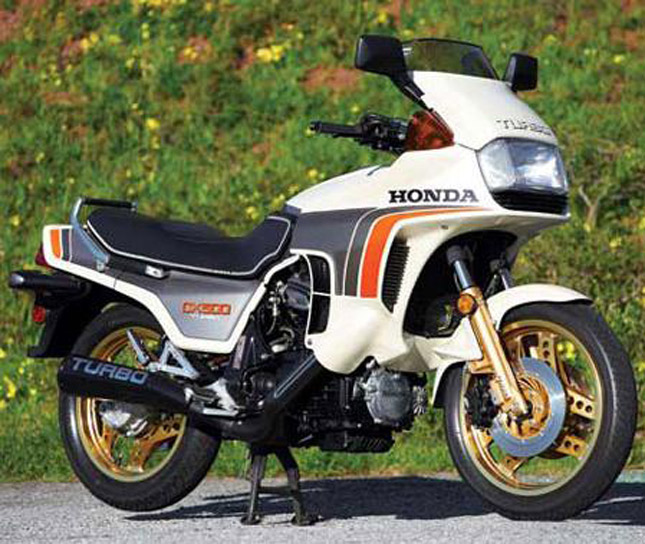 Honda's garish V-twin was the first of the string of turbocharged machines that would see the majority of the enormous four Japanese producers attempt their fortunes with constrained impelling. The Honda was the most inquisitive in its decision of power-plant. Turbochargers, which utilize exhaust gas to compress the intake charge, are most appropriate to large engines that work at a relentless load: the inverse of a bike's circumstance. Likewise, multi-chamber engines help by smoothing the exhaust flow.
Honda's garish V-twin was the first of the string of turbocharged machines that would see the majority of the enormous four Japanese producers attempt their fortunes with constrained impelling. The Honda was the most inquisitive in its decision of power-plant. Turbochargers, which utilize exhaust gas to compress the intake charge, are most appropriate to large engines that work at a relentless load: the inverse of a bike's circumstance. Likewise, multi-chamber engines help by smoothing the exhaust flow.Turbo Background
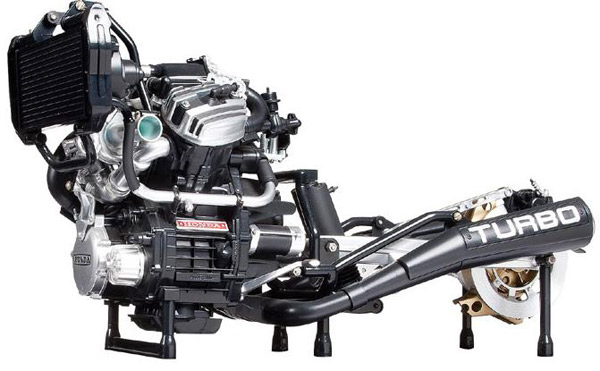 A turbocharger is utilized with an internal combustion engine to give more power, normally over a predetermined RPM. The additional force is provided by the engine's exhaust. Exhaust gasses surging out of the engine under pressure turn a turbine, which spins a compressor, which thus compresses the intake air charge over atmospheric. Obviously, what sounds fairly simple in theory often turns complex in practice. Honda's accomplishment lay in applying the turbocharger idea monetarily, delivering a dependable bike ready to adapt to an variety of conditions.
A turbocharger is utilized with an internal combustion engine to give more power, normally over a predetermined RPM. The additional force is provided by the engine's exhaust. Exhaust gasses surging out of the engine under pressure turn a turbine, which spins a compressor, which thus compresses the intake air charge over atmospheric. Obviously, what sounds fairly simple in theory often turns complex in practice. Honda's accomplishment lay in applying the turbocharger idea monetarily, delivering a dependable bike ready to adapt to an variety of conditions.In motorcycling, the turbo concept started with trials by race groups hoping to get more combustible mixture into engines faster. Most of the GP race teams of the Thirties tried supercharging, a different means to reach the same result. In the 1970s, drag racers introduced turbo units in their bikes, and car manufacturers started to look into turbocharging as an approach to get additional execution out of a smaller engine.
Strengthened Engine
The CX's crankcases were sufficiently solid to be held, however a lot of liquid cooled engine was uprated. A stronger crankshaft, clutch and conrods, in addition to Honda's first production spec forged pistons, all kept it together when the turbo expanded peak power from the standard CX500's 50bhp to the Turbo's 82bhp at 8000rpm.
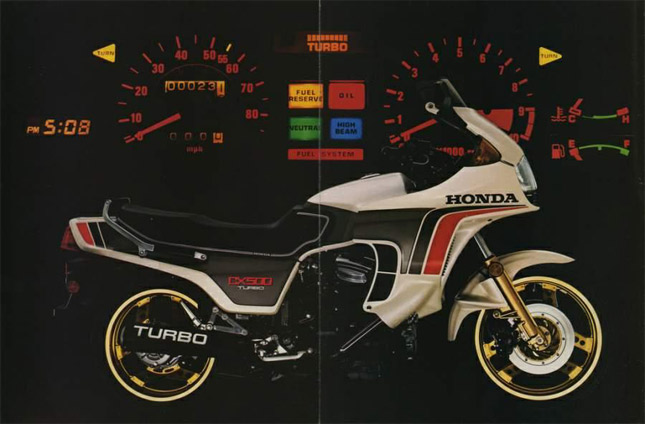
*** Honda CX500 Turbo Instrument Console
Honda's work by no means ended with the power plant. The CX was a rolling showcase for other specialized accomplishments, including its digital ignition and fuel-injection system. Expert Link rear suspension. TRAC anti-dive, twin-piston brake calipers and redesigned Comstar wheels. What's more the fairing, with its lipped screen, colossal headlamp and indispensable indicators, was verifiably upscale. It held a modern instrument comfort that contained a clock and fuel gage, and in addition the turbo boost gage.
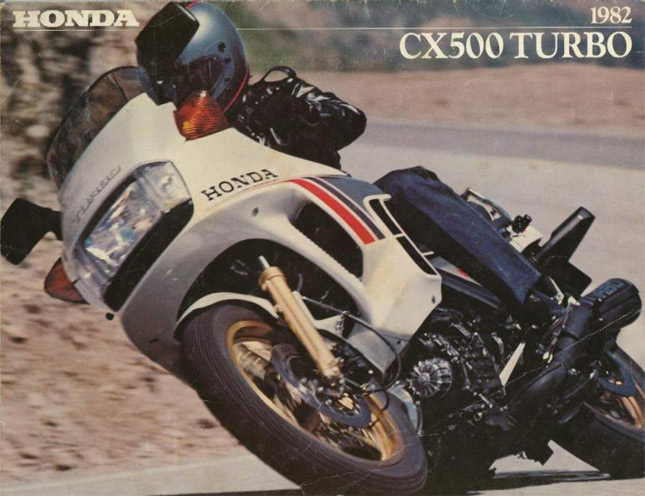 Of course, the CX500 Turbo was never going to be a commercial success. At a price virtually double that of conventional superbikes ad all based on a bike the CX that to sports bike fans had all the appeal of a scooter, it was impossible. But it did cause such a wave of excitement and technical interest that it inspired a whole wave of turbos from rival manufacturers.
Of course, the CX500 Turbo was never going to be a commercial success. At a price virtually double that of conventional superbikes ad all based on a bike the CX that to sports bike fans had all the appeal of a scooter, it was impossible. But it did cause such a wave of excitement and technical interest that it inspired a whole wave of turbos from rival manufacturers.

*** Honda CX650, CX500 & NR 750
Today, the CX Turbo may yet to achieve quite the classic status it deserves. But with a sheaf of technical advances to rival Honda's own NR750, performance that was simply beyond belief, and for causing such a wave of all things turbo in the early 1980s, that day can surely not be far off.
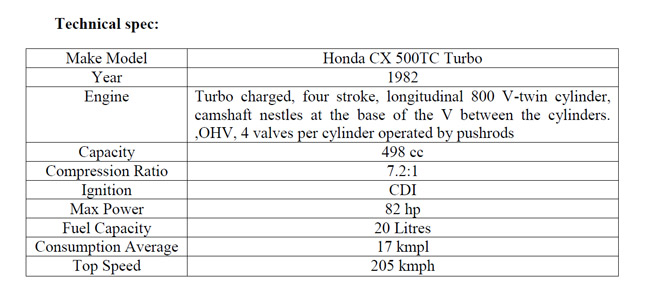 Pic courtesy:
Pic courtesy:1. "Honda CX 500 C" by Foto-dus - Own work. Licensed under CC BY-SA 4.0 via Commons
2. Motorcycle specs
3. Motorcycle classics
4. "Honda CX500 Turbo" by Rikita
By: Rakshit Shastry





